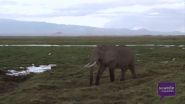These and other LITHOSPHERE papers published online ahead of print on 9 and 17 June are highlighted below.
Along-strike changes in Himalayan thrust geometry: Topographic and tectonic discontinuities in western Nepal
J.E. Harvey, University of California, Santa Barbara, California, USA. Published online ahead of print on 17 June 2015; http://dx.doi.org/10.1130/L444.1.
The Main Himalayan Thrust (MHT) is the plate-boundary fault underlying the entire Himalaya. Convergence along the fault drives uplift of the Himalaya and causes catastrophic earthquakes like the recent Gorkha earthquake in central Nepal. Much of the understanding of MHT geometry comes from studies in central Nepal, and those results are often assumed to project along the range with only minor variations. In this contribution, Harvey and colleagues analyze topography and microseismicity to highlight a major discontinuity in the MHT between central and western Nepal. For an approx. 100-km-long segment west of this boundary, the main "ramp" in the MHT retreats sharply to the north, suggesting that future earthquakes may initiate as much as ~75 km farther north than previously expected. This finding is especially important given the hazard posed by the ~600-year buildup of tectonic stress in the western Nepal seismic gap.
Mid-Miocene initiation of orogen-parallel extension, NW Nepal Himalaya
C. Nagy et al., Geological Sciences and Geological Engineering, Queen´s University, Kingston, Ontario K7L 3N6, Canada. Published online ahead of print on 9 June 2015; http://dx.doi.org/10.1130/L425.1.
Geologic field mapping and structural analysis in the upper Karnali valley of northwestern Nepal confirm the existence of a strike-slip dominated fault, oriented sub-parallel to the Himalayan mountain belt. Age dating of rocks associated with this fault indicates that it has been active since about 13 to 15 million years ago. Data from this study by C. Nagy and colleagues, combined with current understanding of tectonic processes in the Himalaya, suggest that the initiation of this fault represents the onset of mountain belt-parallel extension, concurrent with mountain belt-perpendicular contraction and reverse faulting elsewhere in the Himalaya-Tibet system. Integrating their findings with other chronological constraints from across the Himalaya support the growing recognition of a Himalayan-wide initiation of mountain belt-parallel extension in the mid-Miocene epoch.
The ridge-push force and the state of stress in the Nubia-Somalia plate system
R. Mahatsente, University of Alabama, Tuscaloosa, Alabama, USA, and D. Coblentz, Los Alamos National Laboratory, Los Alamos, New Mexico, USA. Published online ahead of print on 9 June 2015; http://dx.doi.org/10.1130/L441.1.
Although nearly fifty years has passed since the "plate tectonic" revolution in the geosciences, the debate about how the various plate driving forces contribute to plate motion and the intraplate stress field is far from resolved. The question remains: Is plate tectonics a "top-down" (e.g., driven by ridge-push and slab pull) or "bottom-up" (driven by strong coupling from mantle convection) system? In this study, we contribute to this discussion by revisiting the relative importance and contribution of the ridge-push force (RPF) in assisting plate motion and controlling the intraplate stress field; addressing the question of whether the RPF can be transmitted in an oceanic plate or is dissipated in a form of intraplate deformation. In particular, we evaluate the role of RPF in the stress state of the Nubia-Somalia plate system using a comparison of the magnitudes of RPF to the integrated strength of the oceanic part of the plate.
Mantle flow at the highly arcuate northeast corner of the Lesser Antilles subduction zone: constraints from shear-wave splitting analyses
M. Hodges and M.S. Miller, University of Southern California, Los Angeles, California, USA. Published online ahead of print on 9 June 2015; http://dx.doi.org/10.1130/L440.1.
Observed patterns in seismic anisotropy can be used to investigate sub-slab mantle deformation in subduction zones. Here, M. Hodges and M.S. Miller present new measurements of shear-wave splitting from core phases that were conducted using data from twenty seismic stations in the northeast corner of the Lesser Antilles. They observed average fast polarization directions that are parallel to the subduction zone trench. These results suggest that mantle flow is continuous around the highly curved corner of the arc where the plate boundary changes strike from nearly east-west to north-south.
Delineating the Exmouth mantle plume (NW Australia) from denudation and magmatic addition estimates
M. Rohrman, Houston, Texas, USA. Published online ahead of print on 17 June 2015; http://dx.doi.org/10.1130/L445.1.
Traditionally, magmatism on volcanic margins has been attributed to extension related decompression melting, possibly influenced by the presence of a mantle plume. However timing of extension versus mantle plume activity and the influence of magmatism on continental breakup have so far been poorly constrained. Here, it is demonstrated with a dataset from offshore NW Australia that a mantle plume generated the boundary conditions for magmatism and subsequent continental breakup, by analyzing the spatial and temporal pattern of magmatic addition to the crust and resulting erosion. Hot mantle material from the plume generated lithospheric thinning, partial melting and magmatism, weakening existing fault zones and setting boundary conditions for subsequent rifting related magmatism and continental breakup. It is proposed that mantle plumes are relatively weak convective features that could enable breakup instead of driving it.
INFORMATION:
http://www.geosociety.org/
Open-access abstracts for these papers are online at http://lithosphere.gsapubs.org/content/early/recent. Representatives of the media may obtain complimentary PDF copies of LITHOSPHERE articles by contacting Kea Giles at the address above. Please discuss articles of interest with the authors before publishing stories on their work, and please make reference to LITHOSPHERE in articles published. Contact Kea Giles for additional information or assistance. Non-media requests for articles may be directed to GSA Sales and Service, gsaservice@geosociety.org.

